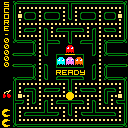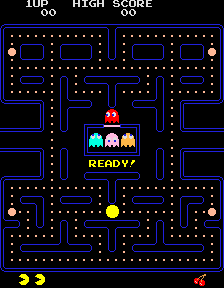The player controls Pac-Man through a maze, eating pac-dots. When all dots are eaten, Pac-Man is taken to the next stage, between some stages one of three intermission animations plays. Four enemies (Blinky, Pinky, Inky and Clyde) roam the maze, trying to catch Pac-Man. If an enemy touches Pac-Man, a life is lost. When all lives have been lost, the game ends. Pac-Man is awarded a single bonus life at 10,000 points by default—DIP switches inside the machine can change the required points or disable the bonus life altogether. Near the corners of the maze are four larger, flashing dots known as power pellets that provide Pac-Man with the temporary ability to eat the enemies. The enemies turn deep blue, reverse direction and usually move more slowly. When an enemy is eaten, its eyes remain and return to the center box where it is regenerated in its normal color. Blue enemies flash white before they become dangerous again and the amount of time the enemies remain vulnerable varies from one stage to the next, but the time period generally becomes shorter as the game progresses. In later stages, the enemies don't change colors at all, but still reverse direction when a power pellet is eaten.
In addition to dots and power pellets, bonus items, usually in the form of fruit appear near the center of the maze. These items score extra bonus points when eaten. The items change and bonus values increase throughout the game.
In the students opinion there are a few main components to Pac-Man.
- The Maze
- The Chase (The ghosts chasing Pac-Man and Pac-Man chasing the ghosts)
- Power Pellets
- Pac-Dots(which all need to be cleared to finish the board)
Aspects, such as the game getting progressively harder, do not seem necessary for this project. The student is not sure if the exact dimensions of the maze will be able to be maintained because the Nokia 6100 is a square and the original arcade machine screen was a rectangle which was just taller than it was wide. The original maze had 29 pellets vertically and 26 horizontally. No straight path connects the top to the bottom. Two straight paths cross the entire screen horizontally.
The 6100 can display 128 pixels in each direction. Assuming a few pixels are left on each side for walls and game status icons and text. 120/29 = 4.14. 120/24 = 5. It may be possible to retain the board dimensions.
Another challenge will be balancing sprite size against maze size. If the sprites are big, they will look good, but the maze will have to be smaller, which could be less fun. If the sprites are to small the maze may be fun to play, but the graphics could look horrible. In the arcade version of Pac-Man, Pac-Man appears to be 12 pixels high and wide. That would be about 1/10 of the screen height or width, using rough measurement the original pac-man would fit across the play-field 14 times vertically and 12 times horizontally. If the same 12 pixel squared pac-man it would be 40% smaller vertically and 20% smaller horizontally than the original Pac-Man maze. This seems like it would cut down on the maze size too much. If the sprite could be reduced slightly, the maze size could be nearly preserved and the sprites may still be recognizable.
Below are examples of a 12x12, 9x9 and 8x8 Pac-Man sprites (with a 1 pixel black border). Which the student created using Paint Free.



The 8x8 pixel sprite is the smallest and looks more round to the student than the 9x9. The 12x12 looks the best, but would also reduce the size of the maze the most. Much bigger than 12x12 and the game would not be much fun because the maze would be to small. Much smaller than 8x8 and the game wouldn't be much fun because it would be too hard to see Pac-Man and the ghosts.
The 8x8 sprites looked promising, so the student took a few hours and did a pixel to pixel mock up of the maze (green walls) at this size and compared it to the original arcade game (blue walls). The student was able to replicate the entire maze from the original, although the mock up feels a bit cramped it seems good for having only 128x128 to work with. The student decided to proceed with the 8x8 sprites and maze mock up shown below. (Look at how well the school colors of UVU are represented in the student mock up!)


The overall design has now been decided. Now each individual part will need to be designed and coded.
No comments:
Post a Comment